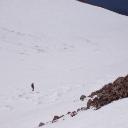Yahoo Answers is shutting down on May 4th, 2021 (Eastern Time) and beginning April 20th, 2021 (Eastern Time) the Yahoo Answers website will be in read-only mode. There will be no changes to other Yahoo properties or services, or your Yahoo account. You can find more information about the Yahoo Answers shutdown and how to download your data on this help page.
Trending News
Is there such a thing as a cold desert?
I have to do make a model of a desert for my environmental sci class
9 Answers
- 1 decade agoFavorite Answer
YES! antartica! My friends made a video... you should check it out.
Source(s): http://www.youtube.com/watch?v=FPnkvJ7qmVI - 1 decade ago
Deserts are defined as areas that receive an average annual precipitation of less than 250 mm (10 in).
so Antarctica is a cold dessert and lots and lots of another places.
- Loren SLv 71 decade ago
CERTAINLY, ALL DESERTS ARE COLD AT NIGHT AND SOME ARE WORSE THAN OTHERS. THE GOBI IN MONGOLIA AND THE ARCTIC TUNDRA WHICH CAN BE CLASSIFIED AS DESERT ARE SOMETIMES VERY COLD. TAKE A LOOK AT THE FOLLOWING.:Geography
A satellite image of the Sahara, the world's largest hot desert and second largest desert after Antarctica.
A satellite image of the Sahara, the world's largest hot desert and second largest desert after Antarctica.
Deserts take up one-third of the Earth's land surface.[1] They usually have a large diurnal and seasonal temperature range, with high daytime temperatures (in summer up to 45 °C or 113 °F), and low night-time temperatures (in winter down to 0 °C; 32 °F) due to extremely low humidity. Water acts to trap infrared radiation from both the sun and the ground, and dry desert air is incapable of blocking sunlight during the day or trapping heat during the night. Thus during daylight all of the sun's heat reaches the ground. As soon as the sun sets the desert cools quickly by radiating its heat into space. Urban areas in deserts lack large (more than 25 °F/14 °C) daily temperature ranges, partially due to the urban heat island effect.
Many deserts are shielded in rain by rain shadows, mountains blocking the path of precipitation to the desert. Deserts are often composed of sand and rocky surfaces. Sand dunes called ergs and stony surfaces called hamada surfaces compose a minority of desert surfaces. Exposures of rocky terrain are typical, and reflect minimal soil development and sparseness of vegetation.
The snow surface at Dome C Station in Antarctica is a representative of the majority of the continent's surface.
The snow surface at Dome C Station in Antarctica is a representative of the majority of the continent's surface.
Bottomlands may be salt-covered flats. Eolian processes are major factors in shaping desert landscapes. Cold deserts (also known as polar deserts) have similar features but the main form of precipitation is snow rather than rain. Antarctica is the world's largest cold desert (composed of about 98 percent thick continental ice sheet and 2 percent barren rock). The largest hot desert is the Sahara.
Deserts sometimes contain valuable mineral deposits that were formed in the arid environment or that were exposed by erosion. Because deserts are so dry, they are ideal places for artifacts and fossils to be preserved.
[edit] Etymology
- WaynerLv 71 decade ago
Yes...Antarctica is a cold desert. The interior gets less than 3 inches of precipitation per year and it's VERY cold.
- How do you think about the answers? You can sign in to vote the answer.
- 1 decade ago
Yes, But so far as I know---only at night. Then the temps drop and it can get cold.





